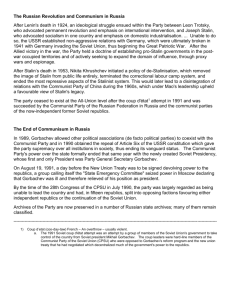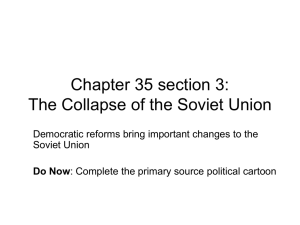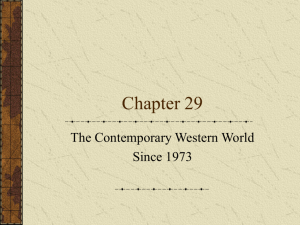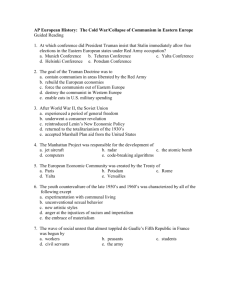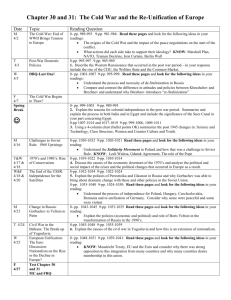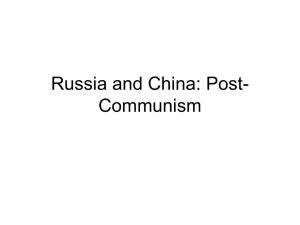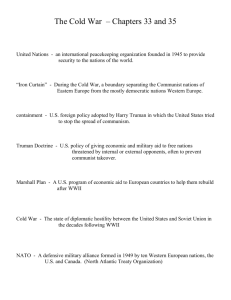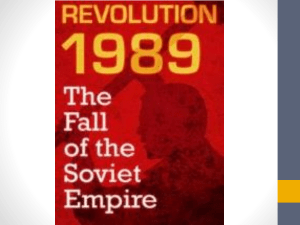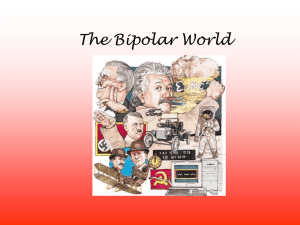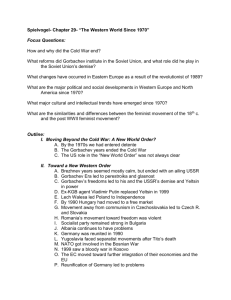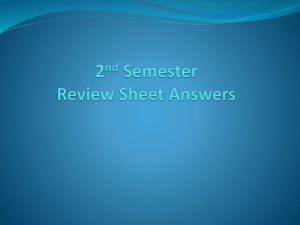COMMUNISM - Loyola Blakefield
advertisement
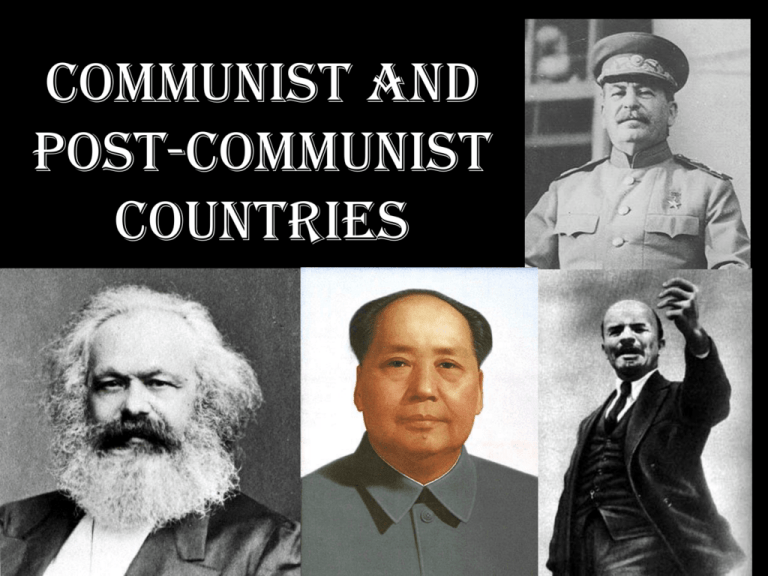
COMMUNIST AND POST-COMMUNIST COUNTRIES Karl Marx • “Father of Communism” • German Socialist • The Communist Manifesto (1848) Principles of Socialism • Private enterprise=unacceptable inequality • Capitalist elite exploit masses • People as a whole should control economic enterprises. • Equality of outcome (no hunger or poverty) Principles of Marxism • Society passes through stages – Pre-modern to industrial • Class conflict – Bourgeoisie (Capitalist elite) – Proletariat (working masses) • Elite create a SUPERSTRUCTURE – Institutions to control the masses • GOVERNMENT • RELIGION Principles of Marxism • Revolution occurs in an industrialized society – Proletariat masses rise up • Post-Revolution – – – – No superstructure No exploitation of worker No private ownership “From each according to his abilities, to each according to his needs.” • Society w/no superstructure=“Communism” Russian Revolution, 1917 • BOLSHEVIKS overthrew Russian government. – “Larger Faction” of Social Democratic Party – Actually: the minority – Eventually call themselves “COMMUNISTS” • V.I. Lenin: Marxist leader of Bolsheviks • Solidified control in 1921. • Renamed Union of Soviet Socialist Republics Leninism v. Marxism • Russia was pre-industrial • A VANGUARD of the REVOLUTION (small group of revolutionary leaders) was necessary to provoke revolution. • DEMOCRATIC CENTRALISM – Rule by a few key leaders. • Primacy of the Communist Party of the Soviet Union (CPSU) • New Economic Policy (NEP) – Allowed some private property and businesses Marxism-Leninism • Marx’s revolutionary anti-capitalism; Lenin’s reliance of communist party-state. • 1924: Lenin dies • Named no successor • 1927: Joseph Stalin took control. Stalin’s Two-Part Plan COLLECTIVIZATION • Ended private ownership (NEP) • Collective Farms – Huge, state-run farms INDUSTRIALIZATION • Forced society to industrialize. • Surplus peasants farmers forced to cities. • Five Year Plan – Double production of all major industries. • Gosplan – Central State Planning Commission created goals for entire economy. Stalinism • Collectivization and industrialization by central planning, executed with force and brutality. PURGES • Millions of citizens and party member killed. • Obsessed with disloyalty within party. • Millions more sent to labor camps (gulag) Command v. Market Economy COMMAND ECONOMY Resource use Determined by and production Central Planning MARKET ECONOMY Ownership of Industry State owns most economic resources Determined by supply and demand. Private ownership of resources. Property Rights Employment Little to none Fully Protected Statecontrolled Individualcontrolled The Party State • CPSU ran the state. • Oversaw all people and institutions. • CPSU only route to success. • 10% of adults were members • Power centered with POLITBURO & SECRETARIAT – Democratic Centralism – GENERAL SECRETARY was head of both Recruitment of Party Elites • Nomenklatura – Lists of “qualified” CPSU members who could fill important party positions. – Secretariat controlled appointments – Elite ruling class Communism and the Cold War • Nikita Khrushchev (1953-64) – Loosened censorship – Denounced Purges – Decreased Cold War tensions • Leonid Brezhnev (1964-1982) – Stagnating economy – Massive military spending Mikhail Gorbachev (1985-1991) New Programs • GLASNOST: – political “openness” – Political dissent • PERESTROIKA: – Economic “restructuring” – Introduce elements of market economy – Private enterprise and private ownership (farms) Flaws in the Soviet System Lack of incentive for workers • “They pretend to pay us; we pretend to work.” • “The system is not working because we are not working.” Flaws of Soviet System Lack of innovation • Nomenklatura – Inbred spoils system – Encourages status quo • RAMPANT BUREAUCRATIC INEFFICIENCY – Poorly planned/run economy Flaws of the Soviet System Excessive Defense Spending • 40% of the Budget • 15-20% of GDP • 4 times greater than U.S. Glasnost: Soviet Republics USSR • 15 republics • 92 different ethnic groups • 112 different languages • Various republics (regions) pushed for independence. • Baltic States: 1989 – Latvia, Lithuania, Estonia 1991 Coup Attempt • Communist hard-liners oppose Gorbachev’s reforms. • 3-day coup • Gorbachev detained at dacha. 1991 Coup Attempt • Boris Yeltsin – President of Russian Republic – USSR’s largest “state.” • • • • Rallied public Opposed Coup Gorbachev resigns USSR disbands – Dec 1991 Commonwealth of Independent States (1991-current) Yeltsin and “Shock Therapy” • Rapid shift to a market economy • Government privatizes “commanding heights” Yeltsin and capitalist “oligarchs” vs. red directors • Power in hands of an elite few – Corruption Impact of Shock Therapy • Massive Inflation – 1986: 20 rubles=$1 – 1997: 5,500 rubles=$1 2011: 30 rubles=$1 • GDP: 1989=500 billion 1999=195 billion • Unemployment: no govt. secured jobs. – 1998: 12% • • • • 16% of population lived on $1-$2 a day. Huge gap between rich and poor Public faith in a market economy dwindled. 1997: Government defaulted on debt. Vladimir Putin • Former KGB spy • Prime Minister under Yeltsin (1999) • Acting president after Yeltsin resigned • Won presidential election (2000 & 2004) Putin & Economy • Stabilized economy after Yeltsin’s 1990s. GDP • 1999=195 billion • 2009= 1.2 trillion • Increase of foreign direct investment (FDI) in Russia • Major exporter of oil. • Modernization
